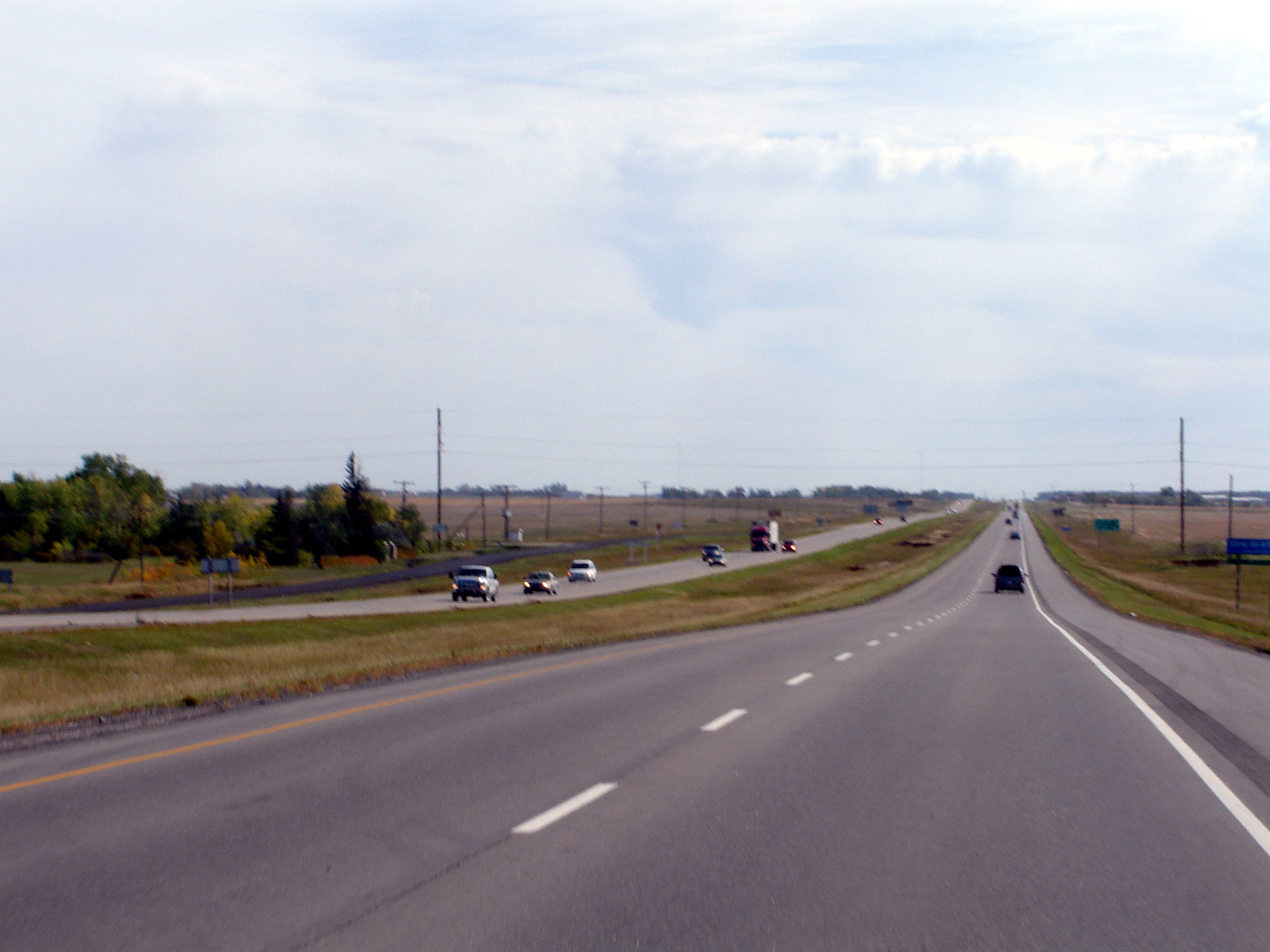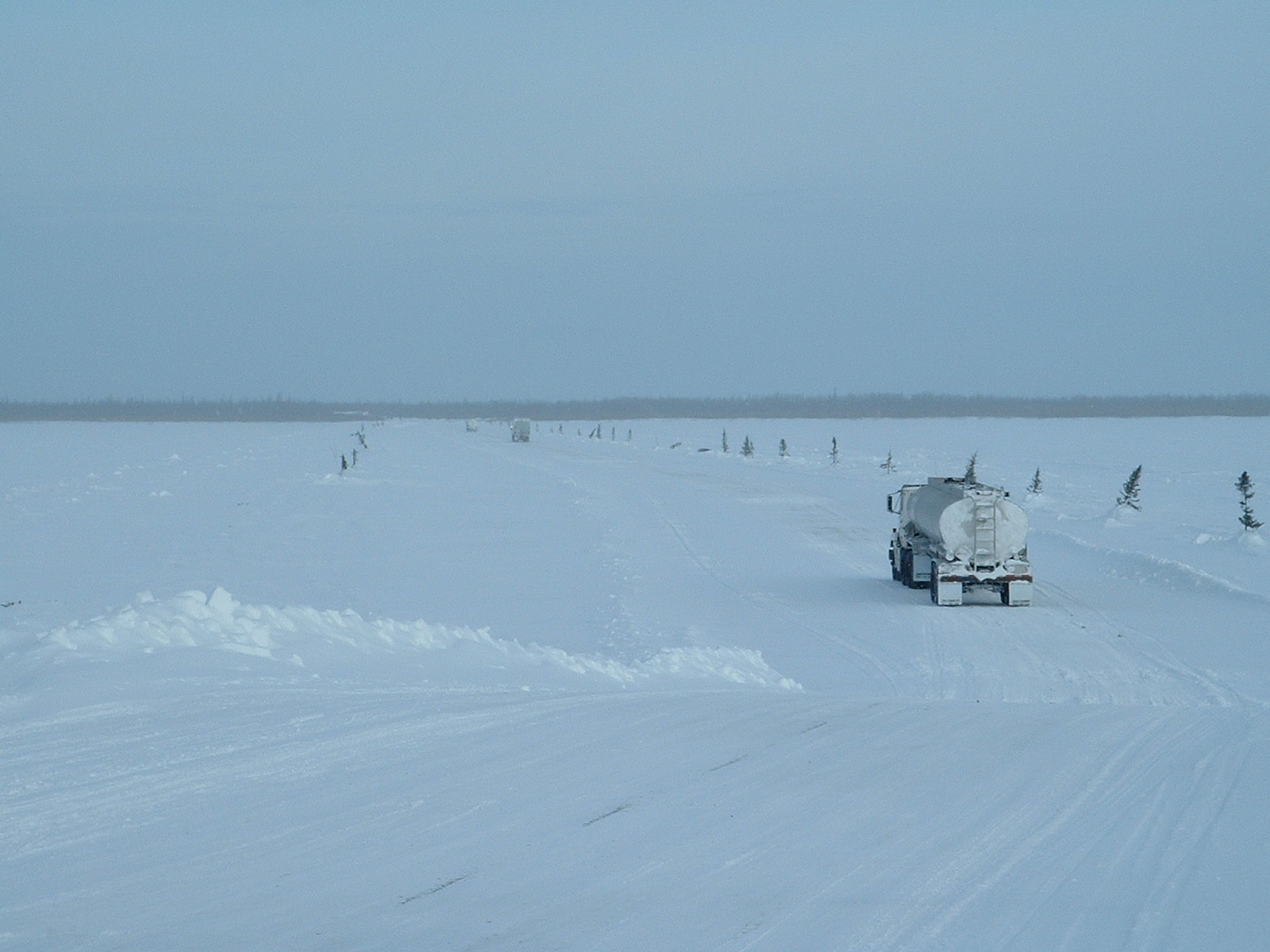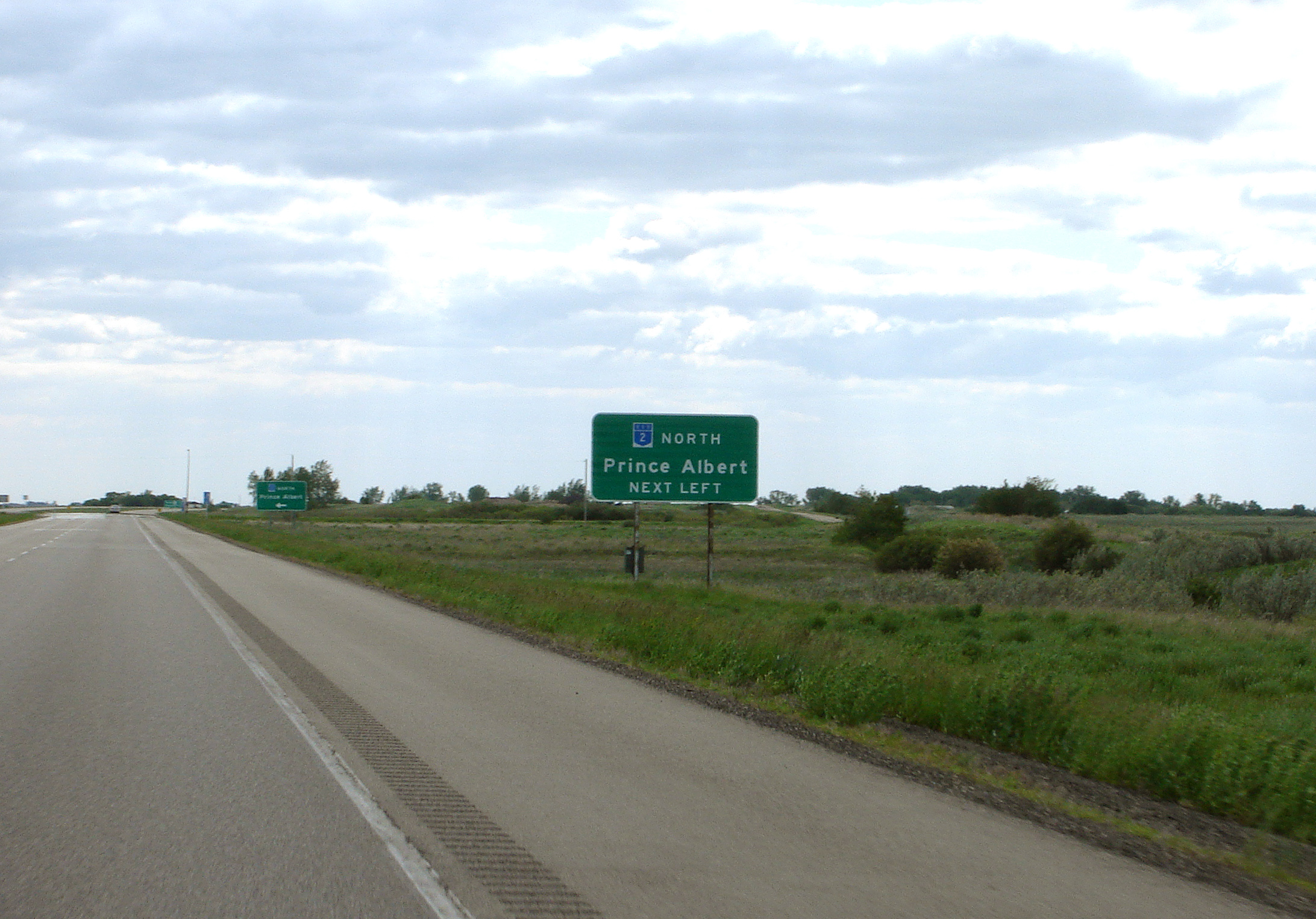|
Saskatchewan Highway 155
Highway 155 is a paved undivided highway in the Canadian province of Saskatchewan. It runs from Highway 55 near Green Lake until La Loche, where it intersects with Highway 955. Highway 155 is about long. Communities accessible directly from Highway 155 are Green Lake, Buffalo Narrows, Landing, Bear Creek, and La Loche. Many provincial recreation sites are also accessible from Highway 155. Highway 155 connects with Highways 55, 165, 965, 908, 925, 909, 956, and 955. History Highway 155 was begun in 1947 as a development road. It reached Buffalo Narrows in 1957 where a ferry was needed to cross the Kisis Channel. The road closely followed the path of the old wagon trail established by the Hudson's Bay Company. The official opening of Highway 155 from Green Lake to Buffalo Narrows was held in August 1963 in Green Lake. The old trail to La Loche was rebuilt soon after to become part of Highway 155. A bridge built in 1981 now crosses the Kisis Channel next to where the ... [...More Info...] [...Related Items...] OR: [Wikipedia] [Google] [Baidu] |
Green Lake, Saskatchewan
Green Lake is a northern village in Saskatchewan, Canada. Its residents are predominantly Métis people. Green Lake is located northeast of Meadow Lake, and northwest of Big River. It lies in the southern boreal forest, and takes its name from nearby Green Lake. Fishing, tourism, and farming, are the major industries. History The Northern Village of Green Lake dates back to 1782, when the North West Company (NWC) established a wintering post on Green Lake. In 1793 the NWC established a permanent post, and in 1810 the Hudson's Bay Company (HBC) established itself on the lake. In 1816-1817, the NWC seized the HBC post and its men, however a HBC post was re-established by 1818, and in 1821 the two companies merged. Shortly after the merger, the Green Lake post was closed for several years, reopening in 1831, and continuing operation until 1973. The Green Lake post was an important post in north-central Saskatchewan, connecting many overland trails with the Churchill River. By ... [...More Info...] [...Related Items...] OR: [Wikipedia] [Google] [Baidu] |
Saskatchewan Highway 909
Highway 909 is a provincial highway in the far north region of the Canadian province of Saskatchewan. It runs from Highway 155, beginning south of the hamlet of Bear Creek, to the settlement of Turnor Lake. It is about long. This access road to Turnor Lake was built when Highway 155 was built to La Loche during the 1960s. Highway 909 was rebuilt beginning in 1997, and this update was completed in September 2001. It is entirely unpaved. Along the highway are local trails leading to lakes. The Palmbere Lake access trail is from the turn-off and the McAnesley Lake access trail is from the turn-off. At the end of Highway 909 in the village of Turnor Lake a road leads south-east to the northern shore of Frobisher Lake. Major intersections See also * Roads in Saskatchewan * Transportation in Saskatchewan References {{Authority control 909 __NOTOC__ Year 909 ( CMIX) was a common year starting on Sunday (link will display the full calendar) of the Julia ... [...More Info...] [...Related Items...] OR: [Wikipedia] [Google] [Baidu] |
Roads In Saskatchewan
Saskatchewan, the middle of Canada's three prairie provinces, has an area of and population of 1,150,632 (according to 2016 estimates), mostly living in the southern half of the province. Currently Ministry of Highways and Infrastructure operates over 26,000 km of highways and divided highways, over 800 bridges, 12 separate ferries, one barge. There are also municipal roads which comprise different surfaces. Asphalt concrete pavements comprise almost 9,000 km, granular pavement almost 5,000 km, non structural or thin membrane surface TMS are close to 7,000 km and finally gravel highways make up over 5,600 km through the province. TMS roads are maintained by the provincial government department: Saskatchewan Highways and Transportation. In the northern sector, ice roads which can only be navigated in the winter months comprise another approximately 150 km of travel. Dirt roads also still exist in rural areas and would be maintained by the local resi ... [...More Info...] [...Related Items...] OR: [Wikipedia] [Google] [Baidu] |
Cluff Lake Mine
Cluff Lake mine is decommissioned former uranium mine located in northern Saskatchewan, located 30 km east of the provincial border with Alberta and approximately 75 kilometres south of Lake Athabasca. The mine and mill were owned and operated by AREVA Resources Canada, formerly COGEMA Resources and is now owned and operated by Orano Canada. History The mine operated from 1981 and used both open pit and underground extraction. Mining infrastructure consisted of a central mill, above ground tailings management area, 3 open pits, 2 underground mines, associated waste rock piles, and site infrastructure including the Cluff Lake airstrip and residences. The mine expected to close in 2000, but additional higher ore grades in the underground mine allowed production to continue for an additional two years. The mine closed in 2002 once the ore reserved were depleted. Total production during the mine's 22-year operating life was over 62 million pounds of yellowcake. Decommissionin ... [...More Info...] [...Related Items...] OR: [Wikipedia] [Google] [Baidu] |
Fort McMurray, Alberta
Fort McMurray ( ) is an urban service area in the Regional Municipality of Wood Buffalo in Alberta, Canada. It is located in northeast Alberta, in the middle of the Athabasca oil sands, surrounded by boreal forest. It has played a significant role in the development of the national petroleum industry. The 2016 Fort McMurray wildfire led to the evacuation of its residents and caused widespread damage. Formerly a city, Fort McMurray became an urban service area when it amalgamated with Improvement District No. 143 on April 1, 1995, to create the Municipality of Wood Buffalo (renamed the RM of Wood Buffalo on August 14, 1996). Despite its current official designation of urban service area, many locals, politicians and the media still refer to Fort McMurray as a city. Fort McMurray was known simply as McMurray between 1947 and 1962. History Before the arrival of Europeans in the late 18th century, the Cree were the dominant First Nations people in the Fort McMurray area. Th ... [...More Info...] [...Related Items...] OR: [Wikipedia] [Google] [Baidu] |
Winter Road
A winter road is a seasonal road only usable during the winter, i.e. it has to be re-built every year. This road typically runs over land and over frozen lakes, rivers, swamps, and sea ice.Proskin et al, 2011. Guidelines for the Construction and Operation of Winter Roads, Transportation Association of Canada.- IHSA, 2014. Best practices for building and working safely on ice covers in Ontario, Mississauga, Ontario, 43 p.- NorthWest Territories Transportation, 2015. Guidelines for safe ice construction, Yellowknife, NWT, Canada, 44 p.Spencer, P.A., Strandberg, A.G. and Maddock, W.A., 2008. Ice and toundra road design for module transport, Proceedings of the 8th International Conference on Ships and Marine Structures in Cold Regions (ICETECH), Banff. Segments of a winter road that cross an expanse of floating ice are also referred to as an ice road or an ice bridge. The foundations underlying over-land segments is most often native soil or muskeg frozen to a given depth, and local ... [...More Info...] [...Related Items...] OR: [Wikipedia] [Google] [Baidu] |
Saskatchewan Highway 2
Highway 2 is a provincial highway in the Canadian province of Saskatchewan. It is the longest highway in Saskatchewan at 809 km (503 mi). The highway is partially divided and undivided. However, only about near Moose Jaw, near Chamberlain, and near Prince Albert are divided highway. Highway 2 is a major north-south route beginning at the Canada–US border at the Port of West Poplar River and Opheim, Montana customs checkpoints. Montana Highway 24 continues south. It passes through the major cities of Moose Jaw in the south and Prince Albert in the north. Highway 2 overlaps Highway 11 between the towns of Chamberlain and Findlater. This section of road is a wrong-way concurrency. The highway ends at La Ronge, where it becomes Highway 102. The highway started as a graded road in the 1920s which followed the grid lines of the early survey system and was maintained by early homesteaders of each rural municipality. Paving projects of the 1950s created all weather ... [...More Info...] [...Related Items...] OR: [Wikipedia] [Google] [Baidu] |
Division No
Division or divider may refer to: Mathematics *Division (mathematics), the inverse of multiplication *Division algorithm, a method for computing the result of mathematical division Military *Division (military), a formation typically consisting of 10,000 to 25,000 troops ** Divizion, a subunit in some militaries *Division (naval) A naval division is a subdivision of a squadron or flotilla. It can also be a subdivision of a fleet. A division is the smallest naval formation, most commonly numbering between two to four ships. Command element A division is usually command ..., a collection of warships Science *Cell division, the process in which biological cells multiply *Continental divide, the geographical term for separation between watersheds *Division (biology), used differently in botany and zoology *Division (botany), a taxonomic rank for plants or fungi, equivalent to phylum in zoology *Division (horticulture), a method of vegetative plant propagation, or the plants cr ... [...More Info...] [...Related Items...] OR: [Wikipedia] [Google] [Baidu] |
Northern Saskatchewan Administration District
The Northern Saskatchewan Administration District (NSAD) is the unorganized area of the Canada province of Saskatchewan. Overwhelmingly larger than the province's other communities, it encompasses approximately half of Saskatchewan's landmass, an area comparable to that of New Zealand. Despite its extent, the majority of Saskatchewanians live in the southern half of the province, and the majority of Northern Saskatchewanians live in incorporated municipalities outside the NSAD's jurisdiction. As a result, the 2016 census counted only 1,115 district residents, which placed its population density at 250 square kilometres for every inhabitant. Because of its extremely sparse population, the district has no local government and is directly subject to the Minister of Government Relations. History An unincorporated Northern Saskatchewan region was first established by the 1948 ''Northern Administration Act''. In 2020, travel into the NSAD was restricted as part of the Government of Sa ... [...More Info...] [...Related Items...] OR: [Wikipedia] [Google] [Baidu] |
Town Centre In Buffalo Narrows, Saskatchewan
A town is a human settlement. Towns are generally larger than villages and smaller than cities, though the criteria to distinguish between them vary considerably in different parts of the world. Origin and use The word "town" shares an origin with the German word , the Dutch word , and the Old Norse . The original Proto-Germanic word, *''tūnan'', is thought to be an early borrowing from Proto-Celtic *''dūnom'' (cf. Old Irish , Welsh ). The original sense of the word in both Germanic and Celtic was that of a fortress or an enclosure. Cognates of ''town'' in many modern Germanic languages designate a fence or a hedge. In English and Dutch, the meaning of the word took on the sense of the space which these fences enclosed, and through which a track must run. In England, a town was a small community that could not afford or was not allowed to build walls or other larger fortifications, and built a palisade or stockade instead. In the Netherlands, this space was a garden, more ... [...More Info...] [...Related Items...] OR: [Wikipedia] [Google] [Baidu] |
Peter Pond Lake
Peter Pond Lake is a glacial lake in Saskatchewan, Canada. It is located in northwestern Saskatchewan in the Boreal Forest and Canadian Shield within the Churchill River drainage basin. It was on the fur trade route to the Methye Portage which connected eastern Canada to the MacKenzie River area. The lake is a long oval tending to the northwest. A peninsula which almost reaches the west shore divides it into Big Peter Pond (the northern two thirds) and Little Peter Pond. On the east side of Little Peter Pond a narrow isthmus separates it from Churchill Lake, the two forming a broad "V". The La Loche River, which drains Lac La Loche comes in from the north while the Dillon River, with the village of Dillon at its mouth, comes in from the west. The lake drains into Churchill Lake through the Kisis Channel at Buffalo Narrows, Saskatchewan. Originally called Big and Little Buffalo Lakes, it was renamed after Peter Pond in 1931. It is on Highway 155 which passes through Buffalo Nar ... [...More Info...] [...Related Items...] OR: [Wikipedia] [Google] [Baidu] |



.jpg)
